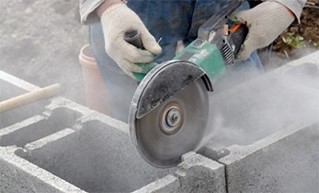Respirable crystalline silica is a common mineral used to make products such as glass, pottery, ceramics, bricks, and artificial stone. It is at least 100 times smaller than sand. Cutting, sawing, grinding, drilling, and crushing stone can result in worker exposures to respirable crystalline silica dust. Industrial sand used in certain instances is also a source of respirable crystalline silica exposure. OSHA has released new respirable crystalline silica standards for construction (1926.1153) and general industry (1910.1053). The permissible exposure limit (PEL) for both construction and general industry is 50 μg/m^3. The action level, where an employer must implement medical surveillance for employees, for both construction and general industry is 25 μg/m^3.
OSHA began enforcing the construction standard September 23, 2017 and the general industry standard June 23, 2018. The new PEL and action level concentrations, expressed in micrograms, are extremely low, and workplace monitoring must be accomplished to determine required actions for compliance.
Nearly 2.3 million people in the U.S. are exposed to silica at work. Employees who inhale these very small crystalline silica particles are at increased risk of developing serious silica-related diseases, including:
- Silicosis, an incurable lung disease that can lead to disability and death
- Lung cancer
- Chronic obstructive pulmonary disease (COPD)
- Kidney disease
What can employers do to protect employees?
Utilize a three-pronged approach to a comprehensive Silica Health & Safety Program:
- Evaluate exposure through air monitoring.
- Control exposure through elimination or engineering controls.
- Protect employees with Personal Protective Equipment (PPE), if necessary; and provide detailed effective workplace training.
Contact Spencer-SHE, for assistance with completion of the elements of the Silica Safety & Health Program. Also, we are equipped with knowledge and tools to assist in the protection of your employees and compliance with the OSHA standards. Specific projects are listed below.
- State of the art air monitoring surveillance is performed by Spencer-SHE for silica exposure evaluations. Observations and recommendations are provided with design solutions.
- Comprehensive Job Hazard Analysis must be completed for all tasks and associated hazards, including Silica. The details include adding engineering controls and specific PPE.
- Silica Exposure Control and Respiratory Protection written programs including medical surveillance management and PPE selection.
- Worker awareness training programs provided through the Spencer-SHE Institute either online or at your facility are currently available.
Photo Source: OSHA.gov

